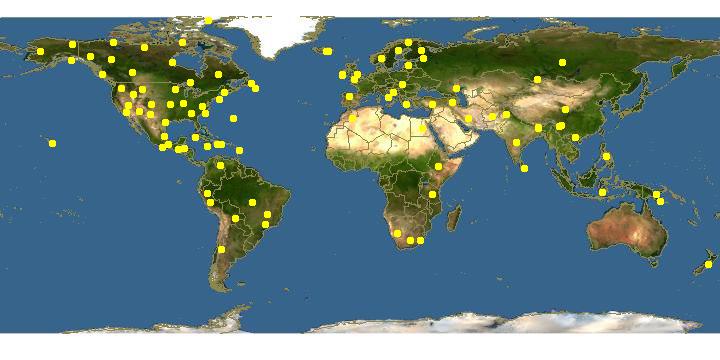1.
Hymenostylium recurvirostrum
(Hedwig) Dixon, Rev. Bryol. Lichénol., n. s. 6: 96. 1934.
Gymnostomum recurvirostrum
Hedwig, Sp. Musc. Frond., 33. 1801
Stems
slender, fragile, 0.5-7 cm.
Leaves
more or less distant; costa ending 1-2 cells before apex to percurrent or short-excurrent as a flat to conical apiculus, occa-sionally ending in a pellucid cell, often scalloped along margins by projecting cell walls, at mid leaf with 2-4 or occasionally several rows of cells across adaxial surface; costa adaxial surface are U-shaped in section; basal cells gradually differentiated, elongate-rectangular, less to nonpapillose proximally, larger than distal cells, 20-50 µm, 2-4:1, walls firm, narrower on the margins, pellucid; distal laminal cells heterogeneous: subquadrate to short-rectangular or rhomboidal, with occasional diagonally transverse walls, longitudinally elongate especially distally near the costa, walls commonly irregularly thickened to porose, marginal cells smaller and more quadrate, ca. 7-10(-12) µm wide, 1-3:1, 1:2, seldom 2-stratose in patches, cell walls superficially flat to somewhat convex, firm-walled; papillae low, simple to 2-fid, 1-3(-5) per lumen, dense to scattered, occasionally absent.
Sexual condition
perigonial terminal and often also lateral proximally.
Seta
single, (0.04-)0.5-0.9(-1) cm.
Capsule
urn 0.5-0.9(-10) mm, often widest at the mouth when dry, exothecial cells thin- to thick-walled, 1-4:1, stomates phaneropore at base of capsule; annulus weakly vesiculose.
Operculum
ca. 0.5-1 mm, usually attached to the columella at least in some capsules.
Calyptra
ca. 1-1.5 mm.
Spores
ca. (13-)17-20(-22) µm.
Varieties 5 (2 in the flora): North America; Central America; South America; Europe; Asia; Africa; Atlantic Islands; Pacific Islands, Australasia.
Hymenostylium recurvirostrum
is distinctive among similar species in having one laminal margin typically recurved, the other erect. A character often overlooked in texts is the universal presence of a long, narrow, fragile decurrency in the basal angles. Both
Gymnostomum aeruginosum
and
Eucladium verticillatum
have an adaxial epidermis in the costal section, with papillose and quadrate cells on the adaxial surface of the costa in plane view, and the costa profile is round (convex), but
Hymenostylium
has long, thin and smooth cells in plane view because the epidermal layer is not developed, and the costal profile is convex adaxially, being lunate in section. In
Anoectangium aestivum
, as in those two species, the dense laminal papillae often obscure cell lumens, but the leaf section shows a very deeply keeled leaf with the leaf lamina adjacent to the costa nearly contiguous or touching, showing a deep, narrow channel in plane view and a circular costa section. The adaxial stereid band is always absent in
A. aestivum
, but often present in
H. recurvirostrum
.
Molendoa sendtneriana
is similar but has a stem central strand, and lateral perichaetia (like
A. aestivum
).

